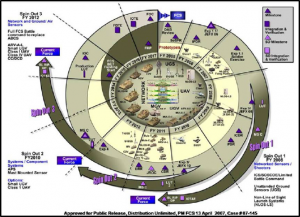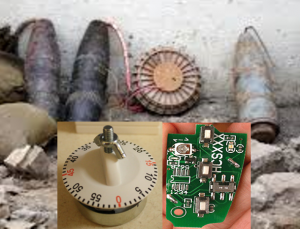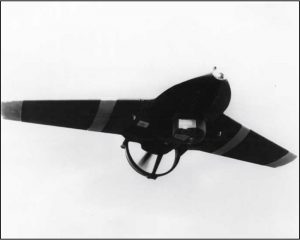[Editor’s Note: In today’s post, returning guest blogger Gary Phillips cautions those who would blindly pursue acquiring the latest, “bleeding-edge,” exquisite technological solutions for our next generation of combat systems. Replete with examples from recent combat history, Mr. Phillips’ post makes a convincing case for resisting the beguiling sirens’ lure of shiny new technological breakthroughs without first considering how these battlefield capabilities could be inexpensively countered by our adversaries with re-purposed, low-tech countermeasures. Read on to learn how “Newer Is Not Better, Better is Better”!]

Many industrialized Western societies have a love affair with technology, the “newer” the better. Planned obsolescence, the idea that no technology or item can last very long before being overtaken by something newer, is the foundation for many industries, most notable the information and computing industry. This cultural bias carries over into the military acquisition system of modern militaries, if the national economies can afford it. The United States has a particular manifestation of this culture demonstrated by a constant drumbeat of pronouncements about the next generation of combat systems and the desire to not just embrace technological enhancements but to pursue them with a dangerous vigor.1

One might argue that current US combat systems like the M1 Abrams tank, and the M2 Bradley belie that argument because they are relatively old. While that argument has some merit, a quick review of history indicates that the M1 and M2 are still around not because of the lack of vigor in chasing new technology, but perhaps due to the tangle of bureaucratic rules and regulations that hamper bringing new technology to the table.
Not every nation or political and ideological entity has the resources to harness new technology for military purposes, even if the information to build the advanced combat system is readily available. The recourse of these actors is to examine what they have on hand, old technology, and determine how it might be used to suppress, mitigate, or deny the effectiveness of a new system built around new technological solutions.
To understand the logic for turning old technology to unintended wartime purposes, one must first have a modest discussion on military theory. The primary purpose of any military is to use force or the threat of force to coerce an adversary into doing something or to stop doing something. The “something” is normally an activity that is either desirable to, or in conflict with, the coercer’s goals or desires. Thus, older technology could be used to change the battlefield calculus and possibly mitigate the coercive potential of “new” combat systems.
One might legitimately ask if given a choice between adopting a new, advanced, and seemingly more effective technology, why would anyone chose to stay with an older technology?
 Perhaps the most obvious reason is cost. In most cases, older technology is on the downward side of the cost curve. Manufacturing practices are well known and well understood, supply chains for materials are established, and in some cases there may be even be a surplus of older systems available for immediate use. One example is the Iraqi insurgent’s use of washing machine timers and infra-red door opening sensors to detonate improvised explosive devices (IEDs).
Perhaps the most obvious reason is cost. In most cases, older technology is on the downward side of the cost curve. Manufacturing practices are well known and well understood, supply chains for materials are established, and in some cases there may be even be a surplus of older systems available for immediate use. One example is the Iraqi insurgent’s use of washing machine timers and infra-red door opening sensors to detonate improvised explosive devices (IEDs).
Older technology also has the benefit of being tested and having known parametrics for use. The capabilities are understood and application in previously unconsidered roles may present themselves more readily. Additionally, the vulnerabilities of older technology have been discovered and, where possible, mitigated. New technology often has unforeseen vulnerabilities that are not discovered until there is a catastrophe that points out the shortfall.
Even though old technology may be more limited than more advanced technology, e.g., wired versus wireless, older technology still in use has proven reliable over time and the mean time between failures has been proven. Newer technology may be more “brittle,” as well as more expensive, and prove to be more of a maintenance headache than an enabler. Finally, sometimes simple problems just need simple solutions. Advanced technology can be expensive and over-structured to address problems that occur on a battlefield. One could ask, how much is enough?
None of the above argue that older technology trumps newer technology; it simply provides some ideas as to why an adversary will re-purpose items. Perhaps the most compelling reason for combat innovation is simply the immediate and persistent need that requires a solider to press into service whatever is available. The presence of a life or mission threatening problem drives soldiers to imagine unintended uses for what they have in their figurative rucksack. Two examples:  welding steel plates on HMMVWs in Iraq as armor protection from side attack IEDs, and the fitting of tanks in World War II with “rhino tusks” to breach the hedgerows in France.2 In both cases, the steel used to build the protection and the tusks came from scrap yards and was modified for the purpose.
welding steel plates on HMMVWs in Iraq as armor protection from side attack IEDs, and the fitting of tanks in World War II with “rhino tusks” to breach the hedgerows in France.2 In both cases, the steel used to build the protection and the tusks came from scrap yards and was modified for the purpose.
How would using old technology in unintended ways change the battlefield calculus? There are at least two ways to do that: drive up the cost to the coercer by reducing the effectiveness of combat systems, and erode trust in the efficacy of the system regardless of actual results.
Making war more costly by reducing effectiveness is the first area where older technology used in unintended ways can have a dramatic effect. More costly, in this context, is causing an adversary to use expensive and often limited technological solutions to counter much cheaper and usually older technological capabilities. Recent conflicts provide many examples. In Bosnia, the extensive use of inexpensive deception measures (e.g., aluminized milk cartons and PVC pipe to build replica air defense systems) drove up the cost to the US in the context of multi-thousand dollar bombs. The Taliban in Afghanistan used water soaked camel blankets to fool US infra-red based intelligence collectors and force continued collection or the dispatch of ground reconnaissance patrols to determine Taliban disposition. The Iraqi insurgents inadvertently thwarted new technology by placing their IED triggers within metal electronic “project boxes.” The US fielded a powerful electro-magnetic pulse (EMP) generator intended to destroy the sensitive electronic components of the trigger. Unfortunately, the metal project box formed a primitive Faraday cage and the electro-magnetic pulse coupled only to the box and bypassed all the trigger components — a multi-million dollar capability stymied by $5.00 project box. Some countries are sensitive to the possibility of non-nuclear EMP in possible future conflicts and chose to use older electronic technologies that, while less capable, provide survivability from EMP – vacuum tubes vice integrated circuits.
Along these same lines, P.W. Singer‘s techno-thriller Ghost Fleet is built around the idea of older technology surviving cyber-attack and being the failsafe when new technology proves to be vulnerable. However, the cost of maintaining two “fleets,” one built around modern advanced technology and the other consisting of older, less capable but more resilient technology is beyond the economic reach of most nations.
 There are dozens of other examples; one recent one is the use of swarming unmanned aerial vehicles (UAVs). UAVs have been around since the 1970’s when the U.S. Army was involved with the Aquila program.3 This relatively old technology has been reborn by adding some simple processors that allow many inexpensive UAVs to fly “in formation” to attack a target.
There are dozens of other examples; one recent one is the use of swarming unmanned aerial vehicles (UAVs). UAVs have been around since the 1970’s when the U.S. Army was involved with the Aquila program.3 This relatively old technology has been reborn by adding some simple processors that allow many inexpensive UAVs to fly “in formation” to attack a target.  This use of old technology with that small tweak allows even 2d and 3d tier militaries to attack expensive state of the art air defense systems, missile systems, and command posts with a greatly enhanced chance of success.
This use of old technology with that small tweak allows even 2d and 3d tier militaries to attack expensive state of the art air defense systems, missile systems, and command posts with a greatly enhanced chance of success.
Eroding trust in a combat system involves the consistent demonstration of an inability to achieve desired effects when the system is employed. How many times will a Soldier fire a weapon or employ a jammer when nothing seems to happen? As mentioned, the unintentional neutralization of the U.S. EMP counter-IED system resulted in Soldiers losing faith in this solution, even when it may have been effective. As a result, the system never completed the fielding process. At what point will Soldiers abandon a seemingly ineffective advanced system and default to something that is less effective but at least appears to work?
The current global security environment signals a move back to great power competition and the potential for great power conflict, which at its worst manifestation requires Large Scale Combat Operations. As U.S. armed forces seek to claim technological dominance over adversaries, we cannot neglect the possibility that whatever new technology the US fields, there may be some relatively “primitive” counter not envisioned during operational testing. As we continue to ride the waves of the information revolution and newer, more advanced technology becomes available, we need to understand that newer is not better, better is better.
If you enjoyed this post, check out our “Tenth Man” — Challenging our Assumptions about the Future Force…
… as well as an alternative perspective in Mission Engineering and Prototype Warfare: Operationalizing Technology Faster to Stay Ahead of the Threat, by Dr. Rob Smith, and Messrs. Shaheen Shidfar, James Parker, Matthew A. Horning, and Thomas Vern, …
… The Democratization of Dual Use Technology, …
… and Mr. Phillips‘ previous blog post, Setting the Army for the Future (Part I)…
Mr. Gary E. Phillips was commissioned from the Reserve Officer Training Corps (ROTC) at the University of Southern Mississippi in February 1974 and entered active duty in April 1974. During his tenure in the military, Mr. Phillips served in a myriad of intelligence and operational assignments, ending his Army career as the Commander of the National Ground Intelligence Center in Charlottesville, Virginia.
Since his selection as a Department of the Army Civilian, Mr. Phillips acted as the Director of TRADOC G2 Threats Directorate. In 2009 Mr. Phillips was selected as a Defense Intelligence Senior Level (DISL) and joined the Senior Executive Service as the Director of the TRADOC G2 Intelligence Support Activity. In 2014, Mr. Phillips became the Assistant TRADOC G2.
Disclaimer: The views expressed in this blog post do not necessarily reflect those of the Department of Defense, Department of the Army, Army Futures Command (AFC), or the Training and Doctrine Command (TRADOC).
1 https://foreignpolicy.com/2018/01/29/americas-military-is-choking-on-old-technology/




Related to the sentence that notes “…older technology surviving cyber-attack and being the failsafe when new technology proves to be vulnerable…” a great example of this was the opening episode of the “Battlestar: Galactica” reboot. The enemy (Cylons) take down the newest Human colony tech, defense systems and sensors, and all current version of their Battlestar carriers via a virus leaving the sole “museum quality” Galactica as the only remaining carrier for use (imagine all carriers and ships in our Navy being taken down leaving nothing but the “Ghost Fleet” and the vast majority of those knowing how to operate them well into retirement–see the movie “Battleship” for an example, somewhat comically done, of bringing WW II vets back to operate and crew the USS Missouri in the face of highly advanced alien invaders)